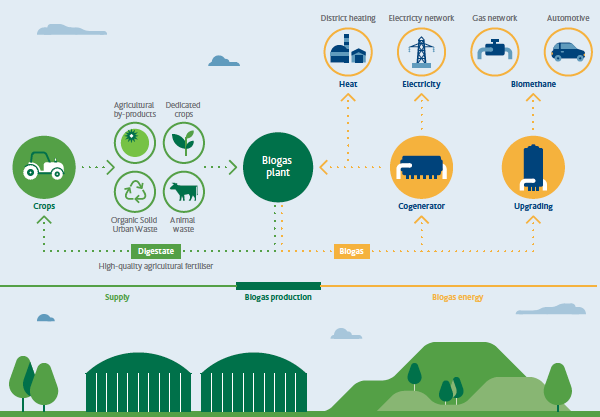New uses of gas

Snam is making a decisive contribution to the development of “production gas” through the development of infrastructures to promote the use of compressed natural gas in the transportation sector, the use of liquefied natural gas and that of biomethane.
Investing in natural gas as a fuel for the automotive industry will result in important economic impacts on the national CNG system, equal to €1.5 billion for the technology and approximately €1.3 billion for the dedicated infrastructures produced in Italy.
More vehicles running on compressed natural gas
Buoyed by a well-established technology and at the cutting edge globally, Italy is the leading European market for the consumption of methane in the automotive industry, with over 1 billion cubic metres consumed in 2015 and approximately 1 million vehicles currently in circulation.
This number could be tripled, with an overall penetration of 7-8% on the total vehicles in circulation, specifically medium-small vehicles, light commercial vehicles and public service vehicles, with an estimated increase in gas consumption of approximately 4-5 billion cubic metres. This consistent expansion would have positive repercussions on the Italian gas system in the transportation sector, which is internationally renowned for its excellence.
An essential factor for achieving growth in a short space of time, in addition to the impetus of methane vehicle manufacturers, will be the doubling of the road and motorway distribution network from the current 1,100 refuelling stations to more than 2,000 over the next ten years.
From an environmental aspect, the realistic goal of replacing the current vehicles in circulation with CNG vehicles (equal to approximately 6% of the total) would generate a reduction in annual CO2 emissions of approximately 40%, nitrogen oxides of approximately 94%, and particulate matter of approximately 95%.
A new partnership for sustainable mobility
The use of vehicles running on CNG could generate savings for families and businesses, with an estimated potential impact of up to €800 million over 5 years.
Snam will contribute to increasing the use of methane in the automotive industry by making its well-established experience in the industry available and by investing around €150 million over the next 5 years to promote the development of refuelling stations and ensuring they are more evenly distributed throughout Italy.
Snam’s commitment comes under the scope of a joint initiative with FCA and IVECO who intend to expand their range of natural gas vehicles.
The memorandum of understanding was signed in October 2016 in the presence of the Minister of Economic Development Carlo Calenda and the Minister of Infrastructure and Transport Graziano Delrio.
Snam and the Api Group signed a letter of intent in December 2016 to develop up to 150 new methane refuelling stations in Italy within the network of Api Group IP points of sale.
New uses of LNG
Snam sees in the new uses of LNG positive aspects for protecting the environment and reducing costs for end users.
Liquefied Natural Gas, in addition to being a key element for guaranteeing greater energy security and diversification of supply, is an economical and efficient solution for reducing emissions produced by land and sea transportation.
These benefits are, however, linked to upgrading existing infrastructures, with special attention to adapting terminals and constructing depots on the coast.
The regasification capacity currently available in Italy is not sufficient to attract new flows of LNG and this is preventing the exploitation of resources coming, for example, from the United States, Africa and the Middle East. Upgrading infrastructures in this area would therefore make it possible to fully exploit the role of alternative fuel instead of conventional fuels.
Small scale LNG
A definition that represents the new frontier for the procurement of Liquefied Natural Gas (LNG). Small gas tankers known as “lighters” can take the product from regasification terminals and directly refuel ships that run on LNG or take the product to coastal depots, to then be sorted by specially equipped lorries.
These lorries can be directly refuelled with LNG from a regasification plant and the liquid gas then transported to the refuelling stations. The stations then refuel heavy land vehicles, lorries and coaches.
To enable the effective launch of this new way of using liquefied natural gas in Italy too, Snam has prepared an action plan initiating a feasibility study aimed at validating possible options for adapting the Panigaglia terminal located in the province of La Spezia. In addition to the traditional regasification service, the upgrading of new Small Scale LNG services is also envisaged, in conjunction with the relevant institutions. Specifically, the feasibility study is aimed at identifying the investments that would allow the loading of LNG onto tankers or lighters, guaranteeing transportation to the consumption points and estimating the costs and times.
Locally-produced LNG
Liquefied Natural Gas can also be produced locally through “refining” biomethane derived from agricultural and livestock residues which is then liquefied, collected and transported like “traditional” LNG.
This has been made possible through the use of “micro-liquefaction” plants which, in terms not yet fully developed from an economic point of view, can also be located along the network to directly use the gas transported in pipelines.
Biomethane: an opportunity for the future
Italy, with 1,500 anaerobic digestion plants in operation is currently the third largest producer in the world of biogas from agricultural sources with approximately 2.4 billion cubic metres produced per year.
Biomethane is a renewable and programmable source in addition to solar and wind power. It is obtained from anaerobic digestion, in special plants, of agricultural and agro-industrial by-products through a biogas upgrading process. It can already be injected into the network and used in all the sectors where gas is present and can also be used as a fuel for road haulage. The increase in its use could make it possible to meet decarbonisation targets, exploiting existing networks and promoting a significant increase in domestic production.
The contribution of biomethane to the goals of decarbonisation is not limited to the energy consumption phase only. The production process can make a contribution to significantly reducing emissions in the agricultural industry and restoring soil organic matter: the digestate (what remains after the anaerobic digestion of the agricultural matter) is actually an excellent natural fertiliser.
Farm businesses could substantially reduce their production costs and increase their competitiveness. A circular economy model capable of not only relaunching agriculture, but more generally the Italian economic and industrial system.
Supporting the national supply of biomethane
Snam, together with the Consorzio Italiano Biogas and Confagricoltura, has developed and presented a manifesto to the public in support of the Italian biomethane supply chain.
The document, directed at the government and the European Commission and circulated on the occasion of the 2016 edition of Biogas Italy, an event in the sector sponsored by the Ministry of the Environment and the Protection of Land and Sea, highlights the strategic role of biomethane in the energy transition to an economy based on sustainability and the circular use of resources.
The first Snam workshop entirely dedicated to biomethane was held in December 2016 at San Donato Milanese. The event, which was attended by around one hundred people, representing over 50 gas transport system operators and associations, helped to take stock of the situation in view of the injection of the first flows of biomethane into the Snam network expected at the start of 2017.
